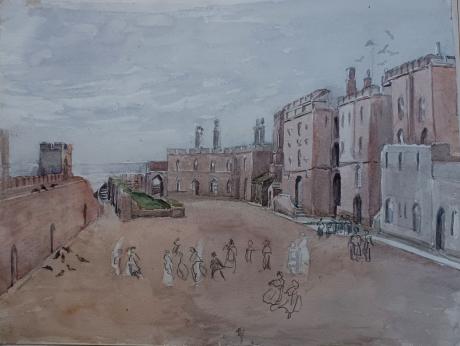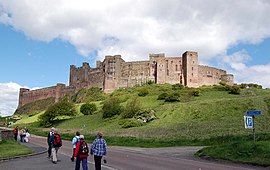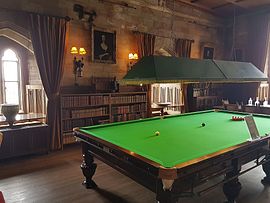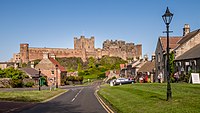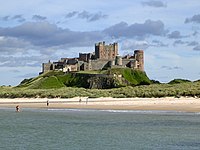signed with initials "TT"
Tom and Laura Taylor and thence by descent
In the inner courtyard (inner 'ward') lie the foundation sof a chapel, which was turned into a little folly when the castle was restored by Armstrong in the 19th century. There may have been seven other buildings in the inner ward, below the existing chapel. The Inner Ward of Bamburgh Castle lies at the heart of the Castle complex. Early mention by Bede notes the presence of a chapel and well. Excavation conducted by the Bamburgh Research Project, between 2004 and 2008, has demonstrated multi-phase activity on the site of the current chapel. Evidence includes early medieval stone-built structures and the butchery of animals in the Roman period.
The focus of the medieval castle, its great hall, royal chambers, kitchen and its church, lay at the summit of the castle rock in the Inner Ward just as the present state rooms do today. In fact, in some instances the current rooms follow the ground plan of their medieval predecessors and even incorporate substantial elements of medieval masonry in some areas. The focus of the most important buildings on the highest and dominant part of the castle rock should come as no surprise to anyone with even the most basic knowledge of castles and their architecture. They are sited here for the views out into the landscape, to be seen from a distance and to look impressive.
The early medieval palace complex of the kings of Northumbria is more elusive, but the little evidence that we do have suggests that the important buildings from this time also lay in the Inner Ward. We have a set of annals, compiled as a follow-on to Bede’s Ecclesiastical History, that was preserved in a later manuscript compiled at Durham. One annal describes Bamburgh and tells us that on the summit of the hill stood a church that contained the relicts of St Oswald and also mentions a well cut through a great depth of bedrock to its west. There was no mention of a great hall, but we know from other royal palace sites, like Yeavering, that one must have been present.The earliest material uncovered was animal bone that had radiocarbon dates from the Roman period. No structures were seen of this date, but clearly at that time people were already living on the castle rock. The most fascinating finds were early stone structures, walls and at least one building, all predating the 12th century as they were beneath the foundations of the 12th century chapel that itself had been built upon in the late 18th and early 19th centuries.
Norman Wall above early medieval wall structure. Two phases of stone wall lay in the northern, seaward, side of the chapel and have been interpreted as early phases of defensive walls. They align with the extensive foundations of the 12th century north wall to the ward that takes a kink to the north in this area and which we believe was re-aligned to extend the size of the ward and incorporate the larger chapel built in the later 12th century. The upper of these early walls has a well-defined chamfer and is of uniform build and is almost certainly Norman in date. The earlier wall beneath it, however, was of a cruder style of build and almost certainly early medieval in date, being two generations earlier than the 12th century chapel.
Inside this wall-line, to the south and beneath the current chapel ruins, we identified lengths of walls that can be combined to make the plan of a rectangular building, some 16m east to west by 8m north to south. Could this just possibly be an earlier church and the very building mentioned by Bede and again by that annalist who continued his history? It would need more work to prove it, but it is a fascinating thought.
The presence of stone buildings, and even potentially a stone defensive wall, from such an early time speaks volumes about the importance of Bamburgh as a palace site for the Northumbrian kings. Clearly, it was a place that they wanted to look impressive and were willing to invest time and resources into.
| Bamburgh Castle | |
|---|---|
| Bamburgh, Northumberland | |

Bamburgh Castle from the southwest |
|
Bamburgh Castle is a castle on the northeast coast of England, by the village of Bamburgh in Northumberland. It is a Grade I listed building.
The site was originally the location of a Celtic Brittonic fort known as Din Guarie and may have been the capital of the kingdom of Bernicia from its foundation c. 420 to 547. In that last year, it was captured by King Ida of Bernicia. After passing between the Britons and the Anglo-Saxons three times, the fort came under Anglo-Saxon control in 590. The fort was destroyed by Vikings in 993, and the Normans later built a new castle on the site, which forms the core of the present one. After a revolt in 1095 supported by the castle's owner, it became the property of the English monarch.
In the 17th century, financial difficulties led to the castle deteriorating, but it was restored by various owners during the 18th and 19th centuries. It was finally bought by the Victorian era industrialist William Armstrong, who completed its restoration. The castle still belongs to the Armstrong family and is open to the public.
history
The southwestern face of Bamburgh Castle, seen from ground level (top) and from above (bottom)
Medieval history
Built on top of a black crag of volcanic dolerite, and part of the Whin Sill, the location was previously home to a fort of the indigenous Celtic Britons known as Din Guarie. It may have been the capital of the kingdom of Bernicia, the realm of the Gododdin people, from the realm's foundation c. 420 until 547, the year of the first written reference to the castle. In that year the citadel was captured by the Anglo-Saxon ruler Ida of Bernicia (Beornice) and became Ida's seat.
The castle was briefly retaken by the Britons from his son Hussa during the war of 590 before being retaken later the same year. Circa 600, Hussa's successor Æthelfrith passed it on to his wife Bebba, from whom the early name Bebbanburh was derived. Vikings destroyed the original fortification in 993.

The Normans built a new castle on the site, which forms the core of the present one. William II unsuccessfully besieged it in 1095 during a revolt supported by its owner, Robert de Mowbray, Earl of Northumbria. After Robert was captured, his wife continued the defence until coerced to surrender by the king's threat to blind her husband.
Bamburgh then became the property of the reigning English monarch. Henry II probably built the keep as it was complete by 1164. Following the Siege of Acre in 1191, and as a reward for his service, King Richard I appointed Sir John Forster the first Governor of Bamburgh Castle. Following the defeat of the Scots at the Battle of Neville's Cross in 1346, King David II was held prisoner at Bamburgh Castle.
During the civil wars at the end of King John's reign, the castle was under the control of Philip of Oldcoates. In 1464 during the Wars of the Roses, it was subject to a nine-month siege by Richard Neville, 16th Earl of Warwick, the "Kingmaker", on behalf of the Yorkists which was marked by the extensive use of artillery.
Modern history
The State Rooms of Bamburgh Castle; in top-centre of middle image, The Card Players, by Theodoor Rombouts, c. 1630
The Forster family of Northumberland continued to provide the Crown with successive governors of the castle until the Crown granted ownership (or a lease according to some sources) of the church and the castle to another Sir John Forster in the mid-1500s, after the Dissolution of the Monasteries. The family retained ownership until Sir William Forster (d. 1700) was posthumously declared bankrupt, and his estates, including the castle, were sold to Lord Crew, Bishop of Durham (husband of his sister Dorothy) under an Act of Parliament to settle the debts in 1704.
Crewe placed the castle in the hands of a board of trustees chaired by Thomas Sharp, the Archdeacon of Northumberland. Following the death of Thomas Sharp, leadership of the board of trustees passed to John Sharp (Thomas Sharp's son) who refurbished the castle keep and court rooms and established a hospital on the site. In 1894, the castle was bought by the Victorian industrialist William Armstrong, who completed the restoration.
During the Second World War, pillboxes were established in the sand dunes to protect the castle and surrounding area from German invasion and, in 1944, a Royal Navy corvette was named HMS Bamborough Castle after the castle.The castle still remains in the ownership of the Armstrong family.
After the War, the castle became a Grade I Listed property. The description included this comment about the status of the building in 1952 and its history:
Castle, divided into apartments. C12; ruinous when acquired by Lord Crewe in 1704 and made habitable after his death by Dr. Sharpe ... Acquired by Lord Armstrong, who had extensive restoration and rebuilding of high quality by C.J. Ferguson, 1894-1904. Squared sandstone and ashlar.
Location

About 9 miles (14 km) to the south on a point of coastal land is the ancient fortress of Dunstanburgh Castle and about 5 miles (8 km) to the north is Lindisfarne Castle on Holy Island. Inland about 16 miles (26 km) to the south is Alnwick Castle, the home of the Duke of Northumberland.
Environmental factors
Air quality levels at Bamburgh Castle are excellent due to the absence of industrial sources in the region. Sound levels near the north–south road passing by Bamburgh Castle are in the range of 59 to 63 dBA in the daytime (Northumberland Sound Mapping Study, Northumberland, England, June 2003). Nearby are breeding colonies of Arctic and common terns on the inner Farne Islands, and of Atlantic puffin, European shag and razorbill on Staple Island.
Archaeology at Bamburgh
Archaeological excavations were started in the 1960s by Brian Hope-Taylor, who discovered the gold plaque known as the Bamburgh Beast as well as the Bamburgh Sword. Since 1996, the Bamburgh Research Project has been investigating the archaeology and history of the Castle and Bamburgh area. The project has concentrated on the fortress site and the early medieval burial ground at the Bowl Hole, located in sand dunes to the south of the castle, evidence of which had first been revealed in a storm of 1817.
During excavations at the Bowl Hole between 1998 and 2007, the remains of 120 individuals from the 7th and 8th century were discovered in that graveyard. The research project was led by Professor Charlotte Roberts of Durham University, and found remains of individuals who had originated from Ireland, Scotland, Scandinavia, the Mediterranean and North Africa.
Finally, in 2016, they were moved into the crypt of St Aidan's Church, Bamburgh; the crypt can be viewed by visitors through a small gate.
The castle's laundry rooms feature the Armstrong and Aviation Artefacts Museum, with exhibits about Victorian industrialist William Armstrong and Armstrong Whitworth, the manufacturing company he founded. Displays include engines, artillery and weaponry, and aviation artefacts from two world wars.
Bamburgh Castle was a civil parish, in 1951 the parish had a population of 18. Bamburgh Castle was formerly a township in Bambrough parish, from 1866 Bamburgh Castle was a civil parish in its own right until it was abolished on 1 April 1955 and merged with Bamburgh.

Selected literary appearances
The castle features in the ballad The Laidly Worm of Spindleston Heugh written in circa 1270. Late medieval British author Thomas Malory identified Bamburgh Castle with Joyous Gard, the mythical castle home of Sir Launcelot in Arthurian legend.
In literature, Bamburgh, under its Saxon name Bebbanburg, is the home of Uhtred Uhtredson, the main character in Bernard Cornwell's The Saxon Stories. It features either as a significant location or as the inspiration for the protagonist in all books in the series, starting with The Last Kingdom, and the sequels The Pale Horseman, The Lords of the North, Sword Song, The Burning Land, Death of Kings, The Pagan Lord, The Empty Throne, Warriors of the Storm, The Flame Bearer, War of the Wolf, Sword of Kings and War Lord.
The castle and also the village provide the setting for the crime novel Bamburgh authored by LJ Ross.
Selected film and television appearances
In addition to appearances as itself, Bamburgh Castle has been used as a filming location for a number of television and film projects:
- 1927: Huntingtower
- 1949: A Connecticut Yankee in King Arthur's Court
- 1964: Becket
- 1971: The Devils
- 1971: Macbeth
- 1971: Mary, Queen of Scots
- 1982: Ivanhoe
- 1984–86: Robin of Sherwood
- 1998: Elizabeth
- 2011: Channel 4's Time Team dig at Bamburgh Castle
- 2015: Macbeth (film)
- 2018: The Last Kingdom (TV series)
- 2023: Indiana Jones and the Dial of Destiny
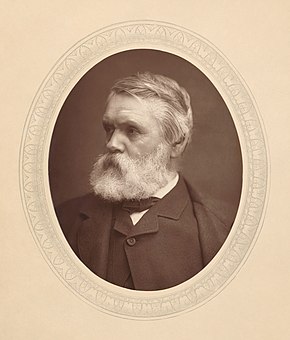
Tom Taylor (19 October 1817 – 12 July 1880) was an English dramatist, critic, biographer, public servant, and editor of Punch magazine. Taylor had a brief academic career, holding the professorship of English literature and language at University College, London in the 1840s, after which he practised law and became a civil servant. At the same time he became a journalist, most prominently as a contributor to, and eventually editor of Punch.
In addition to these vocations, Taylor began a theatre career and became best known as a playwright, with up to 100 plays staged during his career. Many were adaptations of French plays, but these and his original works cover a range from farce to melodrama. Most fell into neglect after Taylor's death, but Our American Cousin (1858), which achieved great success in the 19th century, remains famous as the piece that was being performed in the presence of Abraham Lincoln when he was assassinated in 1865.
Early years
Taylor was born into a newly wealthy family at Bishopwearmouth, a suburb of Sunderland, in north-east England. He was the second son of Thomas Taylor (1769–1843) and his wife, Maria Josephina, née Arnold (1784–1858). His father had begun as a labourer on a small farm in Cumberland and had risen to become co-owner of a flourishing brewery in Durham. After attending the Grange School in Sunderland, and studying for two sessions at the University of Glasgow, Taylor became a student of Trinity College, Cambridge in 1837, was elected to a scholarship in 1838, and graduated with a BA in both classics and mathematics. He was elected a fellow of the college in 1842 and received his MA degree the following year.

Taylor left Cambridge in late 1844 and moved to London, where for the next two years he pursued three careers simultaneously. He was professor of English language and literature at University College, London, while at the same time studying to become a barrister, and beginning his life's work as a writer. Taylor was called to the bar of the Middle Temple in November 1846. He resigned his university post, and practised on the northern legal circuit until he was appointed assistant secretary of the Board of Health in 1850. On the reconstruction of the board in 1854 he was made secretary, and on its abolition in 1858 his services were transferred to a department of the Home Office, retiring on a pension in 1876.
Writer
Taylor owed his fame and most of his income not to his academic, legal or government work, but to his writing. Soon after moving to London, he obtained remunerative work as a leader writer for the Morning Chronicle and the Daily News. He was also art critic for The Times and The Graphic for many years. He edited the Autobiography of B. R. Haydon (1853), the Autobiography and Correspondence of C. R. Leslie, R.A. (1860) and Pen Sketches from a Vanished Hand, selected from papers of Mortimer Collins, and wrote Life and Times of Sir Joshua Reynolds (1865). With his first contribution to Punch, on 19 October 1844, Taylor began a thirty-six year association with the magazine, which ended only with his death. During the 1840s he wrote on average three columns a month; in the 1850s and 1860s this output doubled. His biographer Craig Howes writes that Taylor's articles were generally humorous commentary or comic verses on politics, civic news, and the manners of the day. In 1874 he succeeded Charles William Shirley Brooks as editor.
Taylor also established himself as a playwright and eventually produced about 100 plays. Between 1844 and 1846, the Lyceum Theatre staged at least seven of his plays, including extravanzas written with Albert Smith or Charles Kenney, and his first major success, the 1846 farce To Parents and Guardians. The Morning Post said of that piece, "The writing is admirable throughout – neat, natural and epigrammatic". It was as a dramatist that Taylor made the most impression – his biographer in the Dictionary of National Biography (DNB) wrote that in writing plays Taylor found his true vocation. In thirty-five years he wrote more than seventy plays for the principal London theatres.
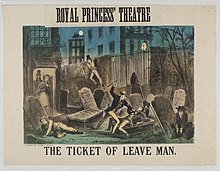
A substantial portion of Taylor's prolific output consisted of adaptations from the French or collaborations with other playwrights, notably Charles Reade. Some of his plots were adapted from the novels of Charles Dickens or others. Many of Taylor's plays were extremely popular, such as Masks and Faces, an extravaganza written in collaboration with Reade, produced at the Haymarket Theatre in November 1852. It was followed by the almost equally successful To Oblige Benson (Olympic Theatre, 1854), an adaptation from a French vaudeville. Others mentioned by the DNB are Plot and Passion (1853), Still Waters Run Deep (1855) and The Ticket-of-Leave Man (based on Le Retour de Melun by Édouard Brisebarre and Eugène Nus), a melodrama produced at the Olympic in 1863.Taylor also wrote a series of historical dramas (many in blank verse), including The Fool’s Revenge (1869), an adaption of Victor Hugo's Le roi s'amuse (also adapted by Verdi as Rigoletto), 'Twixt Axe and Crown (1870), Jeanne d'arc (1871), Lady Clancarty (1874) and Anne Boleyn (1875). The last of these, produced at the Haymarket in 1875, was Taylor's penultimate piece and only complete failure. In 1871 Taylor supplied the words to Arthur Sullivan's dramatic cantata, On Shore and Sea.
Like his colleague W. S. Gilbert, Taylor believed that plays should be readable as well as actable; he followed Gilbert in having copies of his plays printed for public sale. Both authors did so at some risk, because it made matters easy for American pirates of their works in the days before international copyright protection. Taylor wrote, "I have no wish to screen myself from literary criticism behind the plea that my plays were meant to be acted. It seems to me that every drama submitted to the judgment of audiences should be prepared to encounter that of readers".

Many of Taylor's plays were extremely popular, and several survived into the 20th century, although most are largely forgotten today. His Our American Cousin (1858) is now remembered chiefly as the play Abraham Lincoln was attending when he was assassinated, but it was revived many times during the 19th century with great success. It became celebrated as a vehicle for the popular comic actor Edward Sothern, and after his death, his sons, Lytton and E. H. Sothern, took over the part in revivals.
Howes records that Taylor was described as "of middle height, bearded [with] a pugilistic jaw and eyes which glittered like steel". Known for his remarkable energy, he was a keen swimmer and rower, who rose daily at five or six and wrote for three hours before taking an hour's brisk walk from his house in Wandsworth to his Whitehall office.
Some, like Ellen Terry, praised Taylor's kindness and generosity; others, including F. C. Burnand, found him obstinate and unforgiving. Terry wrote of Taylor in her memoirs:
Most people know that Tom Taylor was one of the leading playwrights of the 'sixties as well as the dramatic critic of The Times, editor of Punch, and a distinguished Civil Servant, but to us he was more than this. He was an institution! I simply cannot remember when I did not know him. It is the Tom Taylors of the world who give children on the stage their splendid education. We never had any education in the strict sense of the word yet through the Taylors and others, we were educated.
Terry's frequent stage partner, Henry Irving said that Taylor was an exception to the general rule that it was helpful, even though not essential, for a dramatist to be an actor to understand the techniques of stagecraft: "There is no dramatic author who more thoroughly understands his business".
In 1855 Taylor married the composer, musician and artist Laura Wilson Barker (1819–1905). She contributed music to at least one of his plays, an overture and entr'acte to Joan of Arc (1871), and harmonisations to his translation Ballads and Songs of Brittany (1865). There were two children: the artist John Wycliffe Taylor (1859–1925) and Laura Lucy Arnold Taylor (1863–1940). Taylor and his family lived at 84 Lavender Sweep, Battersea, where they held Sunday musical soirees. Celebrities who attended included Lewis Carroll, Charles Dickens, Henry Irving, Charles Reade, Alfred Tennyson, Ellen Terry and William Makepeace Thackeray.
Taylor died suddenly at his home in 1880 at the age of 62 and is buried in Brompton Cemetery. After his death, his widow retired to Coleshill, Buckinghamshire, where she died on 22 May 1905.

